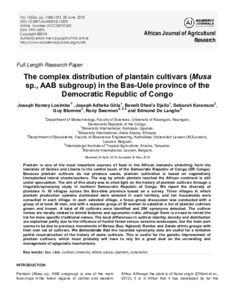| dc.contributor.author | Losimba, J.K. |
| dc.contributor.author | Giria, J.A. |
| dc.contributor.author | Djailo, B.D. |
| dc.contributor.author | Karamura, D. |
| dc.contributor.author | Blomme, Guy |
| dc.contributor.author | Swennen, R. |
| dc.contributor.author | Langhe, E. de |
| dc.date.accessioned | 2019-12-04T11:23:39Z |
| dc.date.available | 2019-12-04T11:23:39Z |
| dc.date.issued | 2018-06-28 |
| dc.identifier.citation | Losimba, J.K., Giria, J.A., Djailo, B.D.A., Karamura, D., Blomme, G., Swennen, R. & De Langhe, E. (2018). The complex distribution of plantain cultivars (Musa sp., AAB subgroup) in the Bas-Uele province of the Democratic Republic of Congo. African Journal of Agricultural Research, 13(26), 1358-1373. |
| dc.identifier.issn | 1991-637X |
| dc.identifier.uri | https://hdl.handle.net/20.500.12478/4087 |
| dc.description | Open Access Journal; Published online: 28 June 2018 |
| dc.description.abstract | Plantain is one of the most important sources of food in the African lowlands stretching from the lowlands of Guinea and Liberia to the central basin of the Democratic Republic of Congo (DR Congo). Because plantain cultivars do not produce seeds, plantain cultivation is based on vegetatively transplanted lateral shoots/suckers. The way by which plantain reached the African continent is still under speculation. The aim of this study was to shed light on the history of plantain cultivars through a linguistic/synonymy study in northern Democratic Republic of Congo. We report the diversity of plantains in 18 villages across the Bas-Uele province based on a survey. Three villages in which plantain production systems dominated were selected in each territory, and ten households were consulted in each village. In each selected village, a focus group discussion was conducted with a group of at least 30 men, and with a separate group of 30 women to establish a list of plantain cultivars grown and known. A total of 46 cultivars were identified and 294 synonyms detected. The cultivar names are mostly related to animal features and agronomic traits, although there is a need to revisit the list for more specific traditional names. The local differences in cultivar identity, density and distribution are explained partly due to the influence of humid forest versus savanna landscapes, but the main part
seems to be due to previous movements of Benza, Boa, Ngbandi, Rambo and Zande ethnic groups with their own set of cultivars. We demonstrate that the recorded synonymy data are useful for a tentative partial reconstruction of the history of some cultivars. This is useful for the genetic improvement of plantain cultivars, which most probably will have to rely for a great deal on the unraveling and management of epigenetic mechanisms. |
| dc.format.extent | 1358-1373 |
| dc.language.iso | en |
| dc.subject | Cultivars |
| dc.subject | Ethnic Groups |
| dc.subject | Plantains |
| dc.subject | Democratic Republic Of Congo |
| dc.subject | Diversification |
| dc.title | The complex distribution of plantain cultivars (Musa sp., AAB subgroup) in the Bas-Uele province of the Democratic Republic of Congo |
| dc.type | Journal Article |
| dc.description.version | Peer Review |
| cg.contributor.crp | Agriculture for Nutrition and Health |
| cg.contributor.crp | Roots, Tubers and Bananas |
| cg.contributor.affiliation | University of Kisangani |
| cg.contributor.affiliation | Bioversity International |
| cg.contributor.affiliation | Katholieke Universiteit Leuven |
| cg.contributor.affiliation | International Institute of Tropical Agriculture |
| cg.coverage.region | Africa |
| cg.coverage.region | Central Africa |
| cg.coverage.country | Congo, Dr |
| cg.creator.identifier | Rony Swennen: 0000-0002-5258-9043 |
| cg.researchtheme | BIOTECH & PLANT BREEDING |
| cg.authorship.types | CGIAR and developing country institute |
| cg.iitasubject | Plant Breeding |
| cg.iitasubject | Plantain |
| cg.journal | African Journal of Agricultural Research |
| cg.howpublished | Formally Published |
| cg.accessibilitystatus | Open Access |
| local.dspaceid | 99425 |
| cg.targetaudience | Scientists |
| cg.identifier.doi | https://dx.doi.org/10.5897/AJAR2018.13202 |

